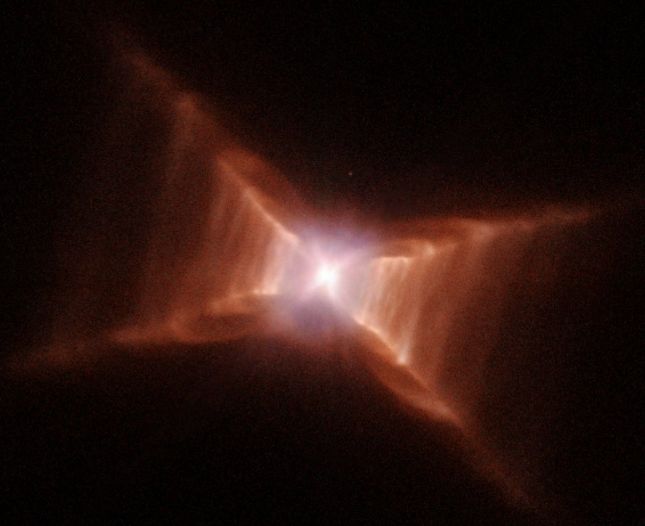
|
Credit & Copyright: H. Van Winckel (KU Leuven),
M. Cohen (UC Berkeley),
H. Bond (STScI).
T. Gull (GSFC),
ESA,
NASA
Explanation:
A distinctive X-shape and ladder-like rungs appear in
this Hubble Space Telescope
image of the intriguing
Red Rectangle Nebula.
The dusty cosmic cloud was originally identified as
a strong source of
infrared
radiation and is now
believed to contain icy dust grains and hydrocarbon
molecules formed in the cool outflow from an aging
central star.
So why does it look like a big X?
A likely explanation is that the
central star - actually a close pair of stars - is surrounded by
a thick dust torus which pinches the otherwise spherical
outflow into tip-touching cone shapes.
Because we view the torus edge-on, the boundary edges of
the cone shapes seem to form an X.
The distinct rungs suggest the outflow occurs in
fits and starts.
About 2,300 light-years away toward the fanciful constellation
Monoceros,
the Red Rectangle nebula should be transformed
into a glorious planetary nebula
as its cool central star becomes a
hot white dwarf over
the next few thousand years.
This sharp Hubble picture spans only about one third of a light-year
at the distance of the Red Rectangle.
|
January February March April May June July August September October November December |
| |||||||||||||||||||||||||||||||||||||||||||||||||||||||
NASA Web Site Statements, Warnings, and Disclaimers
NASA Official: Jay Norris. Specific rights apply.
A service of: LHEA at NASA / GSFC
& Michigan Tech. U.
Based on Astronomy Picture
Of the Day
Publications with keywords: planetary nebula - dust
Publications with words: planetary nebula - dust
See also:
- APOD: 2025 August 31 Á NGC 7027: The Pillow Planetary Nebula
- APOD: 2025 August 28 Á Galaxies, Stars, and Dust
- APOD: 2025 August 22 Á A Tale of Two Nebulae
- APOD: 2025 August 5 Á NGC 6072: A Complex Planetary Nebula from Webb
- APOD: 2025 July 29 Á A Helix Nebula Deep Field
- APOD: 2025 July 13 Á Planetary Nebula Mz3: The Ant Nebula
- APOD: 2025 June 9 Á Between Scylla and Charybdis: A Double Cosmic Discovery
